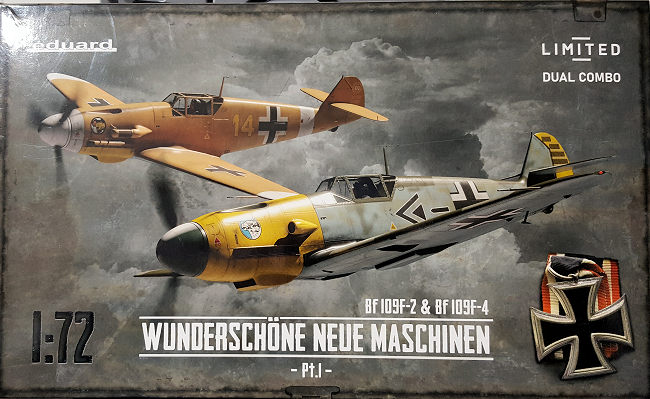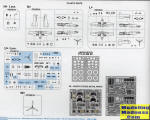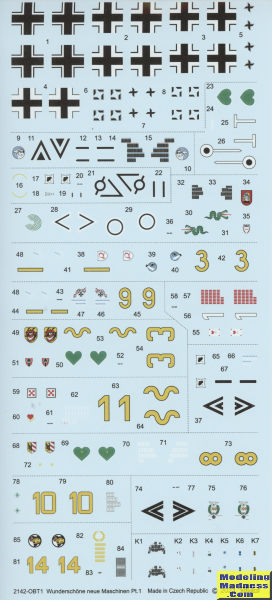
Eduard 1/72 Bf-109F 'Wunderschone Neue Machinen Pt 1'
| KIT #: | 2142 |
| PRICE: | $25.00 delivered on sale |
| DECALS: | 14 options |
| REVIEWER: | Scott Van Aken |
| NOTES: | Profipack includes p.e. and masks |

| HISTORY |
As the DB 601 E was not yet available in numbers, the pre-production F-0 (the only F variant to have a rectangular supercharger intake) and the first production series F-1/F-2 received the 1,175 PS (1,159 hp, 864 kW) DB 601N engine driving a VDM 9-11207 propeller. The F-0/F-1 and F-2 only differed in their armament; the F-1 being fitted with one 20 mm MG FF/M Motorkanone firing through the propeller hub, with 60 rounds. The F-1 first saw action in the Battle of Britain in October 1940 with JG 51. The most experienced fighter aces like Werner Mölders were the first ones to fly Bf 109 F-1s in combat in October 1940. A total of 208 F-1s were built between August 1940 and February 1941 by Messerschmitt Regensburg and the Wiener Neustädter Flugzeugwerke (WNF).
The 1,350 PS (1,332 hp, 993 kW) DB 601 E was used in the F-3 and F-4 model together with a VDM 9-12010 propeller with broader blades for improved altitude performance. The DB 601 E was initially restricted to 1,200 PS (1,184 hp, 883 kW) at 2,500 rpm; however, the full rating of 1,350 PS at 2,500 rpm was cleared for service use by February 1942. The DB 601 E ran on standard 87 octane "B-4" aviation fuel, despite its increased performance; while the earlier DB 601 N required 100 octane "C-3" fuel.
Only 15 examples of the F-3 are believed to have been produced by Messerschmitt Regensburg between October 1940 and January 1941. Like the F-1, the F-3 was armed with the 20 mm MG-FF/M and two 7.92 mm (.312 in) MG 17s.
From the F-4 onward, the new 20 mm Mauser MG 151/20 with 200 rounds was used as the Motorkanone. The first F-4s reached frontline units in June 1941. Production lasted exactly a year between May 1941 and May 1942, with 1,841 of all F-4 variants produced. Some of the later models were capable of mounting two 20 mm MG 151/20 cannons under the wing in faired gondolas with 135 rpg. These were designated F-4/R1 and 240 of them were produced by WNF in the first quarter of 1942. This optional additional armament was standardized as field kit for later G and K series. A special high-altitude variant, the F-4/Z featuring GM-1 boost, was also built with a production run of 544 in the first quarter of 1942 and saw extensive use. Finally, the Erla factory produced 576 tropicalized F-4 trop in the first half of 1942
| THE KIT |
 One
thing that several model companies do is to rescale popular kits. Frequently
this means down-scaling something done in 1/48 to 1/72. Tamiya has done this for
years and Eduard picked up on the practice and has produced a number of
successful offerings. So it was with their 1/48 Bf-109F kits released a short
time ago.
One
thing that several model companies do is to rescale popular kits. Frequently
this means down-scaling something done in 1/48 to 1/72. Tamiya has done this for
years and Eduard picked up on the practice and has produced a number of
successful offerings. So it was with their 1/48 Bf-109F kits released a short
time ago.
This is their combo profipack kit of the Bf-109F offering. It provides enough parts to build either a Bf-109F-1/2 or 4. This includes the upengined 4z and the tropical version. This means there are a lot of sprues in the box. If one wanted they could do 2 -2s or 2 -4s.
 Looking through the instructions one soon sees that there are a lot of
inserts and that Eduard has supplied all the bits needed. This is a Profipack
kit so there are both plastic and photo etch options for a lot of the kit parts.
One could, if so inclined, but a kit with no p.e. at all though it is nice that
the option is there. There is a color p.e. for the cockpit and standard brass
for the rest of the airframe. This includes fins for the bomb so you can be sure
the weekend edition will not include this option. The cockpit is very nicely
appointed and a fair amount of the photo etch is used here. An optional seat is
provided, though instructions state it is rarely used and is not linked with any
specific markings option. Throughout the instructions you have notes as to what
markings option uses what parts.
Looking through the instructions one soon sees that there are a lot of
inserts and that Eduard has supplied all the bits needed. This is a Profipack
kit so there are both plastic and photo etch options for a lot of the kit parts.
One could, if so inclined, but a kit with no p.e. at all though it is nice that
the option is there. There is a color p.e. for the cockpit and standard brass
for the rest of the airframe. This includes fins for the bomb so you can be sure
the weekend edition will not include this option. The cockpit is very nicely
appointed and a fair amount of the photo etch is used here. An optional seat is
provided, though instructions state it is rarely used and is not linked with any
specific markings option. Throughout the instructions you have notes as to what
markings option uses what parts.
You get multiple lower wing pieces as the wheel wells are not the same. You also have optional bits to fit under the lower wing in terms of a drop tank or ordnance. The lower radiator exhaust door is provided as an open or closed piece. Flaps and ailerons along with the rudder are separate as are the slats. Only the flaps and slats have the option of being posed in the lowered position. I should mention that the fin is a separate piece, undoubtedly to allow the fuselage to be used on later model G-6s.
Other optional bits are the sand supercharger intake filter as well as larger oil cooler and wider prop blades for the F-4Z variant. Also optional are different underwing radiators for the F-4. If you wish you can install the engine starting crank and some aircraft had head armor while others also had additional windscreen armor. The cockpit clear bits allow you to pose the canopy open if you wish. Eduard has included canopy and wheel masks, which is part and parcel for the Profipack line.
The instruction book is excellent and 38 pages long. This is partially because you have two separate sets of build sections, one for the F-1/2 and the other for the F-4. There are no fewer than 14 camo/markings option, some of which I've shown. Half of them are for the F-1/2 and half for the F-4. Also included but not shown are two full stencil sheets. The image below shows 10 of these options and one other is shown on the box art. As you can see, lots of choices.

| CONCLUSIONS |
If you are a fan of the 109F and work in 1/72 scale, you really need to consider this set.
January 2024
Copyright ModelingMadness.com. All rights reserved. No reproduction in part or in whole without express permission from the editor.
If you would like your product reviewed fairly and fairly quickly, please contact the editor or see other details in the Note to Contributors.